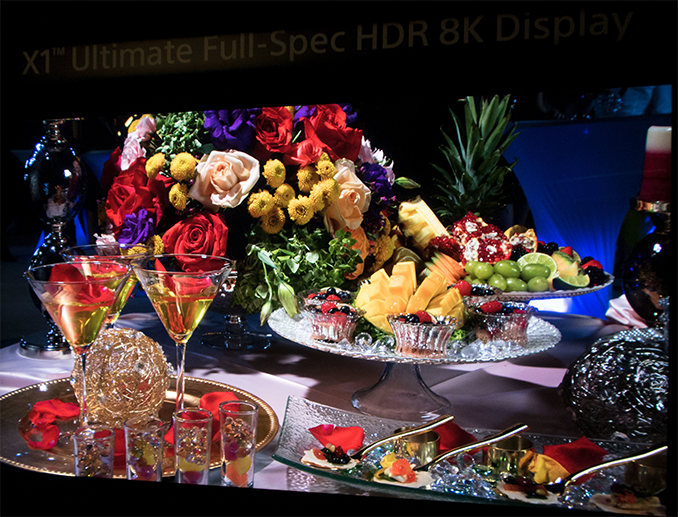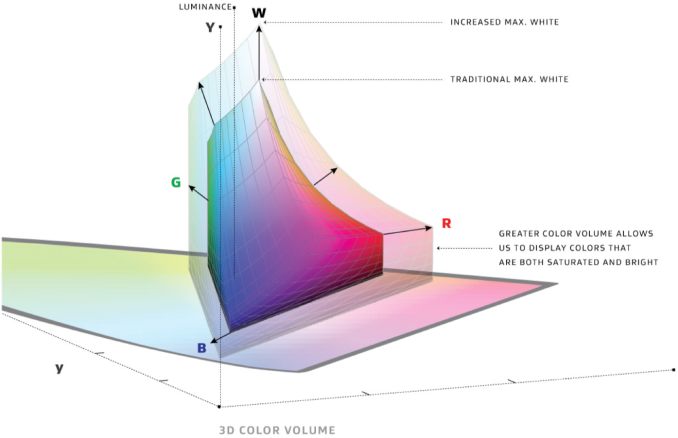Sony Demos Prototype of ‘Full Spec HDR 8K Display’ with 10,000 Nits Luminance
by Anton Shilov on January 11, 2018 7:00 AM EST
LAS VEGAS, NV — Sony demonstrated a prototype of its 8K display with a peak brightness of 10,000 nits at CES 2018. The company did not disclose when it plans to commercialize the product, if at all. While the display’s main feature is extremely high luminance, it packs a bunch of other important technologies, including a new SoC and a new method to keep the contrast ratio high.
Sony calls the prototype it demonstrated at its CES 2018 press conference the “X1 Ultimate Full-Spec HDR 8K Display”. The 85” device with a 7680×4320 resolution relies on an unknown display technology and an undisclosed backlighting system to enable a peak luminance of 10,000 nits.
To put the 10,000 nits number into context. Contemporary high-end UHDTVs offer peak brightness at 1000 – 1500 nits; to get the Ultra HD Premium logo on a TV, the device should have a peak luminance between 540 and 1000 nits (subject to black level performance) and VESA’s DisplayHDR certification currently tops at 1000 nits (black level performance has to be met to get the badge). Then, there is Dolby’s Pulsar reference monitor for Dolby Vision post-production with a peak brightness level of 4000 nits. So, 10,000 nits is a lot. In fact, the Dolby Vision specification supports maximum luminance of 10,000 nits.
A big question is whether this is something that is eagerly awaited by the industry in the foreseeable future because in addition to peak luminance, display panels need to properly support large color spaces, but clearly this is Sony’s technological achievement.
It's interesting to note though that while the most eye-catching aspect of the prototype set is its brightness, that's not the only reason Sony is showing off the set at CES. The display is also a vehicle to show off the company's latest X1 picture processor, in this case being equipped with a pre-production version of Sony’s X1 Ultimate processor that features two times higher “real-time processing power” compared to the current-gen X1 Extreme. The latter is known to support multiple HDR-branded video post-processing techniques, so it is logical to expect its successor to further develop such capabilities.
While high luminance and a wide color gamut are important, contrast ratio is a yet another factor required for a stunning picture on a screen. When it comes to displays with LED backlighting (and I doubt that we are dealing with an OLED-based prototype), precise control of LEDs and calibration of their light beams is a method used by manufacturers to achieve deep blacks today. Several years ago, Sony already demonstrated a 4K display with a 4000-nits brightness featuring its Backlight Master Drive technology that ensured both incredible luminance and a high contrast ratio with its 1000 independently controllable lighting zones. Since technologies tend to evolve, we may be looking at a successor of the Backlight Master Drive tech to be used on the "X1 Ultimate Full-Spec HDR 8K Display”, but a linear growth of the number of controllable lighting zones is hardly the only option that Sony has at hands.
Sony naturally does not disclose any additionally technical details about its prototype. As such, the key takeaways here is that the company had developed an ultra-bright backlighting along with a way to keep the display’s contrast ratio at a decent level as well as a processor that can handle content with peak luminance of 10,000 nits and presumably in a wide color spectrum.
Related Reading:
- Philips Demos 328P8K: 8K UHD LCD with Webcam, Docking, Coming in 2018
- Dell’s 32-inch 8K UP3218K Display Now For Sale: Check Your Wallet
- Dell Announces UP3218K: Its First 8K Display, Due in March
- VESA Announces DisplayHDR Specification: Defining HDR Capabilities In Performance Tiers
- Panasonic Develops IPS Panel with 1,000,000:1 Contrast Ratio, 1000 Nits Brightness
- CEATEC 2016: Sharp Showcases 27-inch 8K 120Hz IGZO Monitor with HDR, also 1000 PPI for VR
Image Source: Tek.No
Source: Sony












21 Comments
View All Comments
haukionkannel - Thursday, January 11, 2018 - link
Really nice!You need sun classes when looking film that is shoot in sahara...
SaolDan - Thursday, January 11, 2018 - link
More like Solar eclipse glasses.bug77 - Thursday, January 11, 2018 - link
It's one the of the reasons for HDR: to show Sahara (or the Sun) as it is.Scootiep7 - Thursday, January 11, 2018 - link
Don't forget your SPF 75 sunscreen.Ahnilated - Thursday, January 11, 2018 - link
I agree, you will need some major sun screen. I wonder how horrible the power draw is going to be.0ldman79 - Sunday, January 14, 2018 - link
That's how dynamic contrast works, right? The TV pulls so many amps that the other lights in the house dim?eSyr - Thursday, January 11, 2018 - link
So, according to Dolby, content is mastered on displays that have worse dynamic range than those this same content is shown on? Good thinking, I'd say.Bullwinkle-J-Moose - Thursday, January 11, 2018 - link
"So, according to Dolby, content is mastered on displays that have worse dynamic range than those this same content is shown on? "------------------------------------------------------------------------------------
Nobody is being held to to Dolby Spec
Dolby Specs are not "THE" Standard for Audio OR Video
You are free to implement Higher or lower specs, either open and DRM Free, or proprietary Crap to hold everyone who believes your bullshit hostage
This is also just one reason that Microsoft's DRM makes their License Null and Void
You cannot Violate National Security and hold everyone hostage by making everyone vulnerable to attacks by creating perpetual backdoors under the guise of DMCA Laws that you only created to prevent anyone else from doing what you yourself are doing
Bullwinkle-J-Moose - Thursday, January 11, 2018 - link
You are free to remove DRM whenever it Violates "YOUR" National Security!Yes, DMCA advocates are on my Terrorist Watch List!
nathanddrews - Thursday, January 11, 2018 - link
I watched an interview with the Sony rep regarding this display and they used their own in-house tools to master content for this prototype to take advantage of the 10K nits maximum. In particular, the PS4 Pro outputs metadata up to 10K nits.